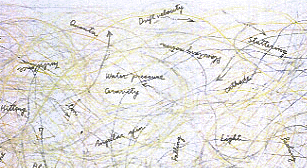
detail from S. Arakawa and M. Gins, "The Energy of Meaning"
The Arrows of the Mind --
Atti del Colloquio Internazionale Future perfect: Italo Calvino and the Reinvention of Literature, tenuto alla New York University, 12-13 aprile, 1999. Italian version published in: Italo Calvino NewYorkese, a cura di Anna Botta e Domenico Scarpa, Cava de' Tirreni: Avagliano Editore, 2002, pp. 117-145. (Le illustrazioni saono tratte dal volume: Arakawa-Gins, Reversible Destiny, S. Guggenheim Foundation, New York: 1997).
The Arrows of the Mind: Calvino, Arakawa and the Hyper-Novel. Abstract
This talk is divided into two parts, in partial disagreement with each other.
Pars construens. "Sometimes I think and imagine that among men there exists a single art and science, and that this is drawing or painting, and that all the others derive from it." Michelangelo's words, quoted by Calvino, provide a viable epigraph to Calvino's own multiple exercises in ekphrasis: descriptions of visual works by congenial artists, in different media, which the writer translates into a reflection on his own art of writing (Mr. Palomar "knows he could never suppress in himself the need to translate, to move from one language to another, from concrete figures to abstract words, to weave and re-weave a network of analogies"). Calvino's readings of Arakawa's paintings (1985) are just such a translation. Calvino sees in Arakawa's works, full of arrows pointing in multiple, enigmatic directions, a picture of the mind, the reflections of a "universal mind" such as the one theorized by Averroes in the Middle Ages. Calvino's descriptions of Arakawa's pictures (or of Steinberg's drawings or of paintings by De Chirico, Giulio Paolini etc.) are conjectural representations of a "virtual" space, a multidimensional hyperspace where lines, arrows and ideas float in continual motion, and "intersect, interpenetrate, or overtake each other." I link these representations to a new form of hyper-narrative, a series of models for the hypernovel.
Pars destruens. In Calvino's own musings on the hyper-novel, from The Count of Montecristo to the fifth memo on Multiplicity, we find a variety of models for the hyper-novel, the "novel as a vast net." Yet, only If On a Winter's Night a Traveler, by dramatizing the demise of the novel as a printed book, reveals the underlying anxiety which accompanies Calvino's lucid premonition of the hyper-novel still to come. This is not just the Author's ambivalent anxiety-elation over his own cunning "disappearance" -- something that Calvino had already welcomed as far back as 1967 in Cybernetics and Ghosts -- but a more subtle anxiety for the future of narrative itself: the anxiety expressed by a lectura interrupta, interrupted or fragmentary reading, linked to the foreseeable end of print culture. Thus, Calvino theorizes, within the physical boundaries of the book, a series of mental models for the hyper-novel which break free of the constraints of print; while, on the other hand, his own hyper-novels in print anxiously thematize the dangers hidden in the demise of print technology (most tellingly expressed in the metaphor of the labyrinth). If the book is destined to lose its (symbolic) consistency and body to the randomness of "photons, undulatory vibrations, polarized spectra...electrons, neutrinos, elementary particles more and more minute...electronic impulses...flow of information, shaken by redundancies and noises," what will happen to narrative art?
The Reader's first impulse and temptation when faced, in chapter 2 of If On A Winter's Night, with the failure of print technology, is to "let it all be degraded into a swirling entropy." The Reader's (and the Narrator's) most profound desire is endangered: "What you would like is the opening of an abstract and absolute space and time in which you could move, following an exact, taut trajectory; but when you seem to be succeeding, you realize you are motionless, blocked, forced to repeat everything from the beginning..." Anyone who has had experience with hypertextual narratives knows that this is precisely the ambivalent feeling they provoke in an empowered Reader abandoned to his/her own freedom: the vertigo of entanglement, the attraction (and horror vacui) of erasure, the liberation from the constraints of closure, along with the aimless wandering of multiple, endlessly repeated "beginnings". This is precisely the game set up by If On a Winter's Night, a sort of narrative endgame in which the combinatory machine of the hyperplot ("the frame that determines and is determined") is both exploited to its extreme and debunked.
Electronic writing seems to embody Calvino's worst fears (by paradoxically disembodying the book/the novel into the information it contains) but it may also give form to his most hidden desires for the future of narrative.
|
Illustrations |
|
 |
N.1 Arakawa-Gins, Mechanism of Meaning. Logic of Meaning. 13. |
 |
N.2 Arakawa-Gins, Mechanism of Meaning. Logic of Mening, 13.2. |
 |
Saul Steinberg,Belgian e-mail. |